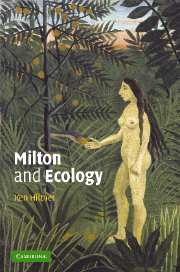Book contents
- Frontmatter
- Contents
- Acknowledgments
- Preface
- Introduction
- PART I HAVING PLACE
- PART II THE UNDERLYING IMPORTANCE OF PLACE
- 5 The New Testament's call to place: Paul's and Luther's deconstructions
- 6 Rejecting the placeless ancient doctrines: confusing Paradise Regained
- 7 The Old Testament's call to place: Job's wisdom in Milton's poetry
- 8 The influence of time on place: forbidding unripe fruit
- 9 Place, body, and spirit joined: the Earth–Human wound in Paradise Lost
- Notes
- Select bibliography
- Index
9 - Place, body, and spirit joined: the Earth–Human wound in Paradise Lost
Published online by Cambridge University Press: 15 December 2009
- Frontmatter
- Contents
- Acknowledgments
- Preface
- Introduction
- PART I HAVING PLACE
- PART II THE UNDERLYING IMPORTANCE OF PLACE
- 5 The New Testament's call to place: Paul's and Luther's deconstructions
- 6 Rejecting the placeless ancient doctrines: confusing Paradise Regained
- 7 The Old Testament's call to place: Job's wisdom in Milton's poetry
- 8 The influence of time on place: forbidding unripe fruit
- 9 Place, body, and spirit joined: the Earth–Human wound in Paradise Lost
- Notes
- Select bibliography
- Index
Summary
whose tallest Pines,
Though rooted deep as high, and sturdiest Oaks
Bow'd thir Stiff necks, loaden with stormy blasts,
Or torn up sheer: ill wast thou shrouded then,
O patient Son of God, yet only stood'st
Unshaken
(Paradise Regained, 4.417–21)In terms of my earlier discussions on the necessity in continuing to feel the wound opened up at the Fall, the need to confront in fear and trembling the fallen human state is forever connected in Paradise Lost to the wounded state of the Earth. Milton's unique contribution is that, with the image of a wounded Earth, he is able to connect both Old and New Testament wisdoms by exploiting the typology surrounding both the Fall and Christ's crucifixion. To understand how this is achieved we need to consider, in terms of typology, the wounding of the Earth.
Although it is not surprising that Eve feels wounded at the Fall, it is rather unexpected that Milton's sentient Earth feels the “wound.” Given that, as Diane McColley has noted, in the iconography of Milton's time there was a tradition approaching a “typology of regeneration,” making “the Fall a type of Crucifixion,” it would seem far more likely that if an account of the Fall depicted a common “wound” being opened at all, it would have been shared by humanity and Christ. In the chronology of Paradise Lost, long before Eve's lapse, the Son has offered “life for life” (3:236) as Atonement for human Sin.
- Type
- Chapter
- Information
- Milton and Ecology , pp. 125 - 134Publisher: Cambridge University PressPrint publication year: 2003



